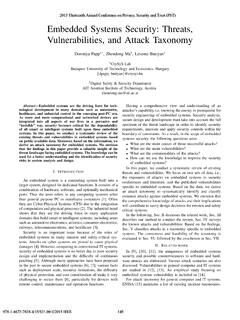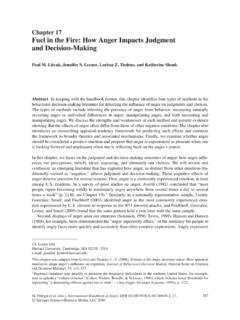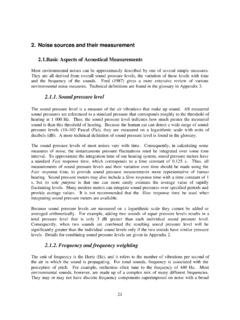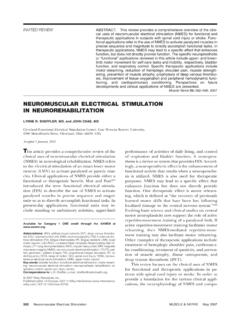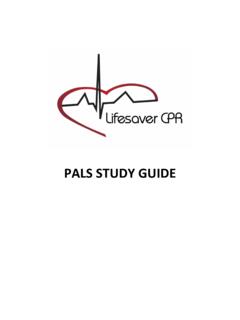Transcription of Validating and Monitoring the Cleanroom
1 6-1 OverviewMany have fallen into the trap of spending huge amounts of money building a Cleanroom with little thought and understanding of what is required to get it up and running and the subsequent main-tenance of it. It is vital, even at the start, to see that the desi gn of the Cleanroom , with regard to the -quences with regard to cost of modifying or redesi gning the facility and having proto cols that cannot start, that the process within the room is not posi ng a risk to the environment, that personnel working within the Cleanroom are following proto col, and that products manufactured or processes performed -ing microbial contamination levels.
2 Once validation has been completed, a comprehensi ve plan should desi gning, Validating , and monito ring of Designthat they may not need a Cleanroom of such a high class, that the support rooms may be to o small for Cleanroom except through the gowning room, that they have no material transfer room included, that 6 Validating and Monitoring the CleanroomOver vie w ..6-1 Cle anr oom Design ..6-1 Prin ci ples of Cle anr oom Validatio n and Tes tin g ..6-2 Cle anr oom Validatio How Does One Determine What Tests Need to Be Performed during a Cleanroom Validation? Microbial Validation Testing Validation ReportValidatio n ver sus Moni torin g ..6-7 Routine Particulate Monitor ing Establishing an Environmental Monitoring ProgramSummary.
3 6-12 Ref er ences ..6-13 Kevina O 11/6/2011 3:40:58 PM6-2 Handbook for Critical Cleaning: Applications, Processes, and Controlsthey are unsure of what kind of services will be required in the Cleanroom that will lead to further drill-ing and construction at a future date, and so on. In other words, they have a Cleanroom built that will now not service the requirements of their current product. Making changes at this stage can become very costly and inconvenient in comparison to building and designing it correctly in the first process itself should be the main driver of the design of the Cleanroom . The process should dic-tate the level of contamination control required, and hence the class of the Cleanroom , not the industry (Hansz 2008). Unlike many facilities, a Cleanroom must be designed from the inside out.
4 All efforts to control contamination within a Cleanroom are directed at people; therefore the flow and movement of people within the Cleanroom must be taken into consideration during the design. In the author s opin-ion, this is one of the most neglected aspects of Cleanroom design. The process within the Cleanroom should have a layout that minimizes the movement of personnel as much as rooms are vital for a Cleanroom to work effectively; , a spacious gowning room is required for Cleanroom personnel to enter and leave concurrently and gown without difficulty; the gowning room must allow enough space to store all required apparel. A material transfer room or hatch that incorporates a wipe down area is fundamental. All materials, paperwork, and equipment should enter the Cleanroom through the material transfer room or hatch after receiving a thorough clean down.
5 A separate area or transfer hatch that allows the transport of finished products out of the Cleanroom may also be incorporated into the design. One of the most forgotten areas during the design stage is how waste is removed from the Cleanroom . If no facility has been put in place during the design to allow waste to leave the Cleanroom area, more often than not, it is removed through the gowning room. This undesirable practice in turn will affect the process flow and can have serious implications on contami-nation levels within the gowning greater the considerations as to the exact contamination controls that are built into the clean-room design, the more appropriate the specific Cleanroom facility design will be for the manufacturing process and operations in question.
6 The appropriate level of quality should be designed and constructed into the facility and systems that support the production process. The development of the Cleanroom design, based on the contamination controls required for the process, should necessitate the develop-ment of the operational protocols, the first one being the Cleanroom validation of Cleanroom Validation and TestingIn order to show that the Cleanroom environment is in control , it is necessary to demonstrate that the air supplied to the Cleanroom is of sufficient quantity to dilute or remove the contamination generated within the Cleanroom and that the air supplied to the Cleanroom is of a quality that will not add signifi-cantly to the contamination levels within the Cleanroom . It is important that the air moves in the correct direction from clean to less clean areas and that the air movement within the Cleanroom demonstrates that there are no areas within the room with high concentrations of contamination (Whyte 2010).
7 It also important to demonstrate, from a microbial perspective, that operations and manufacturing can be performed within an environment that meets its microbial contamination ValidationWithin highly regulated environments such as medical device and pharmaceutical industries, there is a requirement to provide an appropriate amount of assurance that critical processes can be performed within controlled conditions in order to produce a final product that is of eminent quality, reliable, and safe for the end popular assumptions, Cleanroom validation is, unfortunately, more than just counting par-ticles. It encompasses many different tests that have to be carried out in various Cleanroom states in order to show that the Cleanroom is fit for its intended use and that the Cleanroom meets the required 21/6/2011 3:40:58 PMValidating and Monitoring the Cleanroom 6-3 There are an assortment of standards and guidance documents available to help with this, such as IEST Testing Cleanrooms, IEST HEPA and ULPA Filters, IEST , Considerations in Cleanroom Design, and the European Union Guide to Good Manufacturing Practices (EU GGMP).
8 However, IS EN ISO 14644 is the prime standard adhered to for validation of Cleanroom environ-ments. This standard does not consider specific processes within the Cleanroom . Rather, it provides constructional guidance for the start-up and qualification of the Cleanroom environment detailing the basic elements needed to ensure continued satisfactory operation and to the IS EN ISO 14644-2 standard, every time a Cleanroom is put into operation initially or changes its intended use, a validation must be performed. The initial setup of a Cleanroom requires a validation to be performed over a specified period of time to ensure that the Cleanroom is function-ing as required over the given period of time. Over this period of time, historical data are collected to ensure that the Cleanroom is performing effectively.
9 Changes made to an existing Cleanroom require an assessment of how the changes will affect the Cleanroom as this in turn will decide how extensive the revalidation will be. Either way, this testing certifies that the Cleanroom environment meets the stated standards, protocols, and design mentioned, validation testing is performed when the Cleanroom is in different phases or occu-pancy states. The various terms used for the phases or occupancy states are detailed in Table , when a Cleanroom is certified to a specific class, the room performs to a standard that meets or exceeds the performance of that class under a specific occupancy How Does One Determine What Tests Need to Be Performed during a Cleanroom Validation?The majority of companies get an independent testing and certification body to outline an appropri-ate testing program and perform the required testing.
10 IS EN ISO 14644-1 determines the type and frequency of testing required to conform to the standard. Some tests are mandatory and some are optional. A typical testing program will include the following tests:Airflow Volume and Velocity TestsThe more clean air supplied to the Cleanroom , the cleaner the room will be. A Cleanroom must have suf-ficient clean air supplied to dilute or remove any airborne contamination that may be present. This air Table Different Phases and Occupancy States of Testing Performed during a Cleanroom ValidationTesting Phase TermsOccupancy StateTest ResultsAs built testing phase 1, installation qualification, post-build approvalTesting is performed where the installation is complete with all services connected and functioning but with no production equipment, materials, or personnel presentProves that the environment was correctly installed and meets its intended design specificationAt rest testing phase 2, operational qualificationTesting is performed when the equipment is installed and operating in a manner agreed upon by the customer and supplier, but with no personnel presentProves that all parts of the installation operate together to achieve the required conditions.
